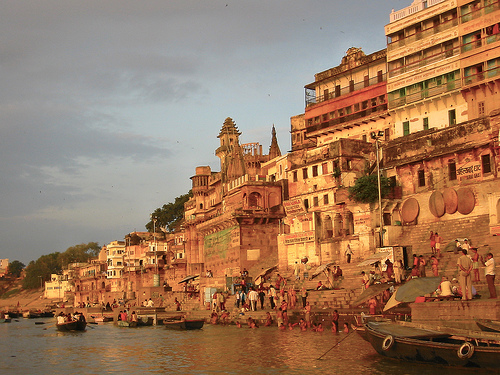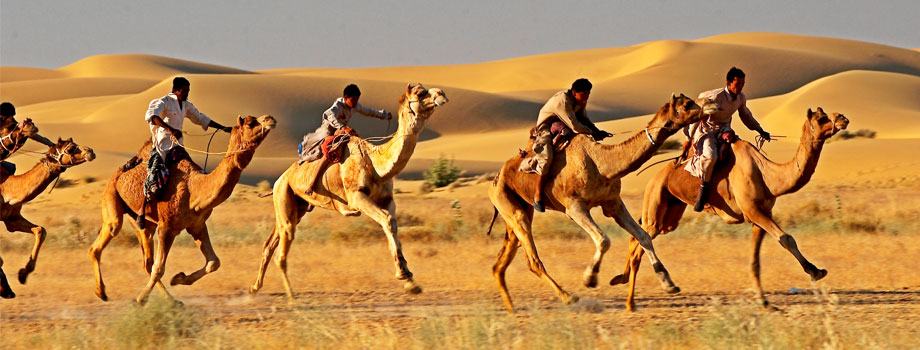-
Wild LIfe in India
India is home to many National parks and Wildlife sancturies within d Read more -
Kerla
With the Arabian Sea in the west, the Western Ghats towering 500-2700 m in Read more -
Taj Mahal
The Taj Mahal is one of the most wonderful tourism destinations in India an Read more -
Varanasi
The land of Varanasi (Kashi) has been the ultimate pilgrimage spot for Hind Read more -
Jaisalmer
The History of Jaisalmer has a charm of its own. Like all other cities of R Read more -
Amber Fort
Established in the year 2005, at JAIPUR (RAJASTHAN, India) we, "SHOW Read more
VARANASI
 Varanasi is the symbol of undying faith to millions of devotees who throng the Ghats and temples of this holy city. The significance of Varanasi/ Kashi can be gauged from the fact that Hindus from different parts of India wish to spend their last days in the eternal city to attain liberation. This very facet of the holy city pulls curious westerners as well as diehard devotees to her fold.
Varanasi is the symbol of undying faith to millions of devotees who throng the Ghats and temples of this holy city. The significance of Varanasi/ Kashi can be gauged from the fact that Hindus from different parts of India wish to spend their last days in the eternal city to attain liberation. This very facet of the holy city pulls curious westerners as well as diehard devotees to her fold.Historical information about Varanasi:
The ultimate pilgrimage spot for Hindus since the days of yore, Varanasi is believed to have been the abode of Lord Shiva and Goddess Parvati, who stood upon this land at the beginning of time. Mark Twain had rightly said "Benares is older than history, older than tradition, older even than legend, and looks twice as old as all of them put together." The city has been a seat of learning and civilization for more than 3000 years. For centuries, the town has witnessed the flourish of knowledge, philosophy, culture, devotion to Gods, Indian arts and crafts. With the holy Buddhist pilgrimage spot of Sarnath being just 10 km away from Varanasi, the latter is also holy place for Buddhists. Believed to be the birthplace of Parsvanath, the 23rd Jain Tirthankar
Ganga Aarti
Every evening at five, a magical aarti is performed at Dasashwamedh Ghat. Halt your boat right at the steps for the best view. The presiding priests stand on a wooden chauki in the water. To the chant of Sanskrit mantras, and the clash of cymbals and drums, the river is worshipped with flowers, incense, sandalwood, milk and vermilion. First the blazing camphor lamp and then the many- flamed aarti lamps are raised high and then arched back to the water, the dark river reflecting the golden flames as Ganga accepts the worship
Vishwanath Temple Aarti : There are five daily aartis at Vishwanath Temple. Elven priests prepare the black stone linga for the aarti amidst loud chanting . the linga is first bathed in the holy waters of Ganga, and then anointed with sandalwood paste, and an intoxicating concoction of cannabis or bhang, honey, ghee and finally milk. It is decorated laveshly with garlands of marigold, rose and jasmine, till the stone shaft is completely buried. Finally, to the sound of conch shells, bells and drums, the many-flamed oil waved before the god. the whole temple precinct is suffused with the heavy fragrance of dhoop. the ritual ends as the music reaches deafening crescendo that reverberates down the lane
"The Ghats of Varanasi : Varanasi's major tourist attraction are the long stretch of ghats, which line the west bank of the Ganges. Ghats are the steps which lead down to the river. There are around ghats in Varanasi, each with its own significance. Most Indians believe that anyone dying on the banks of the river, in Varanasi, attains instant 'moksha' or enlightenment.
Durga Temple : The eighteenth century Durga Temple is also known as the Monkey Temple due to the presence of the many monkeys that live here. Durga is represented as the embodiment of shakti or female power, clad in red, riding a tiger and fully armed with Shiva's trident, Vishnu's discus and a sword.
Bharat Mata Temple : This unique temple has a huge relief map in marble of the whole of Indian subcontinent and Tibetan plateau installed instead of icons of gods and goddesses.
Alamgir Mosque : The Alamgir Mosque is also known as Beni Madhav Ka Darera and is a blend of the Hindu and Mughal styles of the architecture. The mosque was built by Aurangzeb on the site of the Vishnu Temple.
Tulsi Manas Temple : This temple is dedicated to Lord Rama and is situated where the great medieval seer Tulsidas is believed to have lived and written the great epic 'Shri Ramcharitmanas'.
Vishwanath Temple : The temple is located in the premises of the Banaras Hindu University and was by the Birlas. It was planned by Pandit Madan Mohan Malaviya and is open to all irrespective of caste or creed.
Banaras Hindu University : The Banaras Hindu University is one of the oldest educational centres in India which was built in 1917. Its campus is spread over five square kilometres and houses the Bharat Kala Bhavan, which has a fine collection of miniature paintings, sculptures from first to fifteenth centuries, old photographs of Varanasi and brocade textiles.
Excursions in Varanasi :
Varanasi has numerous excursion sites located nearby. Some of the major cities are listed below.
Sarnath : Sarnath is a major Buddhist centre where Buddha preached his message of the 'middle way' to nirvana after achieving enlightenment at Bodhgaya. It is located 10 kilometres from Varanasi and Ashoka erected the Famous Stupa here. Several Buddhist structures were built here in Sarnath.
Kushinagar
Kushinagar lies about 51 kilometres from Gorakhpur, and is famous for the Mahaparinirvana (death) of Lord Buddha. The town was once celebrated as the centre of the Malla kingdom and has many stupas and viharas that date back to 230 BC-413 AD





